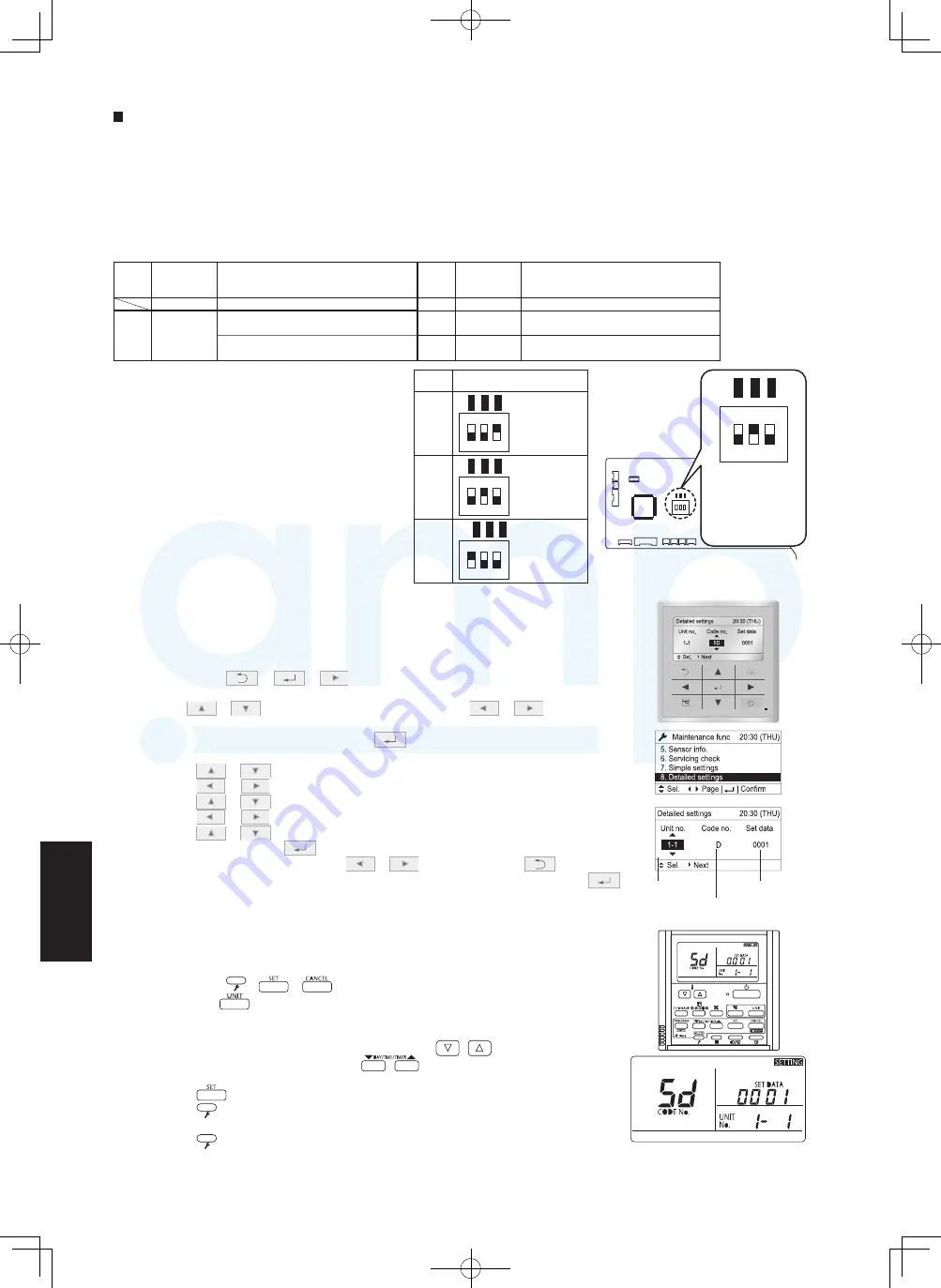
7
7
Optional Controller
Remote Controller Functions
1. Remote Controller Servicing Functions
Functions
Description
Button operation
Reset operation
Unit status
Test run
Operation with forced
thermostat ON
Press the
button.
Current operation
is maintained.
Sensor
temperature
display
Temperature display
from each sensor
Servicing
check display
Alarm history display
Simple
settings
Filter lifetime, operating
mode priority, central
control address, and
other settings
When settings
are made from a
remote controller,
the indoor unit
where that remote
controller is
connected stops.
Detailed
settings
System address, indoor
unit address, central
control address, and
other settings
Automatic
address
Automatic address
setting based on
command from the
wired remote controller
Automatic reset
Entire system
stops.
Address
change
Change of indoor unit
address
Press the
button.
CZ-RTC4
Press and hold the
button for
4 seconds or longer.
Press and hold the
and
buttons for 4 seconds or longer.
Press and hold the
and
buttons for 4 seconds or longer.
Press and hold the
,
and
buttons for 4 seconds or
longer.
Press and hold the
and
buttons for 4 seconds or longer.
Press and hold the
and the
timer operation
buttons for 4
seconds or longer.
Press and hold the
and the
timer operation
buttons for 4
seconds or longer.
The remote controller includes a number of servicing functions. Use these as needed for test runs and
inspections.
Fig. 7-6
List of Servicing Functions
<Procedure>
DC Fan Tap Change Procedure
It is necessary to set the fan speed in accordance with the intended application and the optional parts to be
used if any such part is used. (Table 1)
If this speed is not changed, a reduction in the air flow may result, causing the air outlet temperature to drop
and condensation to form during cooling.
There are two ways to set the fan speed: either (1) change the positions of the DIP switches on the indoor unit
control PCB or (2) set the speed using the wired remote controller. Select one of these ways.
* Priority is given to setting the fan speed by changing the positions of the DIP switches.
TP6
TP3
TP1
1
ON
2 3
TP6
TP3
TP1
1
ON
2 3
Intended application /
name of optional parts
Setting
No
(1)
Item code
5D/5d
setting data
0001
0000
Standard (factory setting)
High-ceiling setting 1
(with standard, ECONAVI panel)
Air-flow blocking kit
(when a duct is connected.)
Intended application /
name of optional parts
Setting
No
Item code
5D/5d
setting data
(3)
(6)
0003
0006
Air-flow blocking kit (for 3-way air flow)
High-ceiling setting 2
(with standard, ECONAVI panel)
Air-flow blocking kit
(for 2-way air flow)
<Procedure> Be absolutely sure to turn off the
power (earth-leakage circuit breaker).
<1> On Table 1, check out the “Setting No.” that
corresponds to the intended application and
the optional parts to be used.
<2> Open the cover of the electrical parts box, and
check the indoor unit control PCB. (Fig. 7-5)
<3> Select the Setting No. which was checked out
on Table 1, and change the positions of the
DIP switches on the indoor unit control PCB.
(1) When setting the fan speed by changing
the positions of the DIP switches on the
indoor unit control PCB
(2) When setting the fan speed using a wired remote controller
(optional parts: CZ-RTC5A)
“OFF” position
1 2 3
TP6
TP3
TP1
1
ON
2 3
DIP switch
DIP switch
Setting
No.
“OFF” position
“ON” position
DIP switch
“OFF” position
“ON” position
TP6
TP3
TP1
1
ON
2 3
DIP switch
“ON” position
TP6
TP3
TP1
ON
(3)
(6)
(1)
In the example
shown in the figure
above:
DIP switch 1 is OFF.
DIP switch 2 is ON.
DIP switch 3 is OFF.
On Table 1, check out the “Item code 5D setting data” that corresponds to the intended
application and the optional parts to be used.
(3) When setting the fan speed using a wired remote controller
(optional parts: CZ-RTC4)
On Table 1, check out the “Item code 5d setting data” that corresponds to the intended
application and the optional parts to be used.
<1> Hold down the + + buttons together for at least 4 seconds.
The maintenance function screen is displayed.
<2> Use the / buttons to select the display and the / buttons to
select the page.
Select “8.Detailed settings” and press the button.
The [Detailed settings screen] appears.
Using the / buttons, select the unit No.
<3> Using the / buttons, select the item code.
Using the / buttons, change the item code to “5D.”
<4> Using the / buttons, select the setting data.
Using the buttons, change the setting data to the value checked out
on Table 1, and press the button.
<5> After selecting the unit No. using the / buttons, press the button.
The [Detailed settings completion screen] appears. Select “Yes” , and press the
<1> Hold down the + + buttons together for at least 4 seconds.
<2> Each time the button is pressed, the numbers of the indoor units under group
control are displayed in sequence.
The fan motor of only the indoor unit that has been selected will run.
<3> Specify item code “5d” using the temperature setting / buttons.
<4> Change the setting data using the hour buttons. The setting data details
are as given on Table 1.
<5> Press the button. (OK if the display changes from flashing to lighted.)
<6> Press the button. The normal stop status is established.
Go to step <2> to change the selected indoor unit.
<7> Press the button. The normal stop status is established.
(1)
0001
5
Unit No.
Setting data
Item code
<Procedure> Ensure that the units have stopped operating before changing the fan speed.
<Procedure> Ensure that the unit has stopped operating before changing the fan speed.
DC fan motor tap setting table
(Table. 1)
Indoor unit control PCB
(Fig. 7-5)
SM830255-00_Single_欧州4方向 TD&SM.indb 18
16/09/21 13:54:53
7-16
SM830252-01_欧州_Single_8・10HP_TD_SM.indb 16
16/10/13 11:02:04
AMP Air Conditioning
www.ampair.co.uk | [email protected]
















































